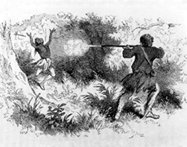
Robert Jenkins Onderdonk, Fall of the Alamo, 1903, Texas State Archives.
March 6, 1836: Following a thirteen-day siege, more than 2000 Mexican troops launched a pre-dawn attack from all four sides on the fortress defended by 180 men. The Mexicans were repulsed twice, but a third assault gained the north wall and broke through the west wall. After fierce fighting, the defenders were killed to a man. The casualties included Colonel William Barret Travis, James Bowie, and former Congressman from Tennessee David Crockett.





OneGuy
So basically Spanish and English colonists fighting over indigenous land after most of the indigenous people are gone.
JDZ
In 1836, the Comanche were anything but gone, and if they were anywhere near you, you’d have devoutedly wished they were gone.
Boligat
A number of years ago my wife and I visited The Alamo. Wandering the empty hall, I felt a shiver up my spine, knowing what happened there. It moved me. My wife did not have the same reaction, but she was too polite to mention it.
Oh, by the way, did I mention that my wife is a Mexican National?
OneGuy
The name Comanche is derived from a Ute word meaning “anyone who wants to fight me all the time.”
The Comanche had previously been part of the Wyoming Shoshone. They moved south in successive stages, attacking and displacing other tribes, notably the Apache, whom they drove from the southern Plains. By the early 1800s the Comanche were very powerful, with a population estimated at from 7,000 to as many as 30,000.
As a father of Indian children and a long time admirer of Indian life and culture, I did indeed know that the Comanche were still a viable and dangerous force in Texas at that time. But by that time they were outnumbered by Mexican and Americans who were armed and ready to fight back and Comanches were mostly limited to attacking travelers and small groups.
Please Leave a Comment!